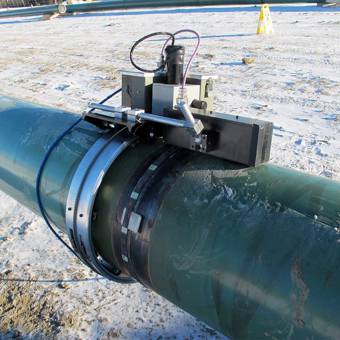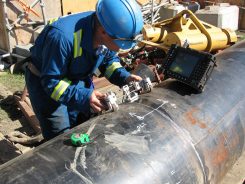Shield Your Financial Investment: Thorough Pipeline Welding Inspection for Peace of Mind
Necessary Pipe Welding Evaluation Tips for High Quality Assurance
In the realm of pipeline construction, the integrity of welds holds paramount relevance to make certain the safety and security and effectiveness of the entire system. From natural gas to refined oil items, pipelines form the lifeline of various sectors. Just how can one ensure the quality of these welds that connect the pipe sections? The solution depends on precise evaluation techniques and adherence to rigorous quality control criteria. By comprehending the vital pipeline welding examination tips, professionals can prevent possible dangers, decrease costly repair services, and support the reliability of these important facilities.

Significance of Welding Examination
Welding evaluation plays a crucial role in making sure the structural stability and safety of pipe systems. By meticulously taking a look at welds, inspectors can determine any kind of problems or blemishes that might endanger the integrity of the pipe. These inspections are necessary for preventing leaks, tears, and other potentially disastrous failures that could cause environmental damage, monetary losses, and also loss of life.
The value of welding examination can not be overstated, as the high quality of welds straight impacts the overall performance and long life of the pipeline. Through non-destructive testing approaches such as aesthetic inspection, ultrasonic testing, radiography, and magnetic bit screening, assessors can spot problems that might not show up to the nude eye. By recognizing and addressing these problems early, welding examination aids to ensure that pipelines meet market requirements and governing needs.
Ultimately, welding inspection is an important element of quality control in pipe upkeep, building and construction, and fixing (Pipeline Welding Inspection). By promoting strenuous assessment requirements, market professionals can mitigate risks and promote the safety and security and dependability of pipeline systems
Common Welding Issues
Amongst the obstacles dealt with in pipeline welding, usual issues can dramatically affect the structural honesty and efficiency of the welded joints. Several of one of the most prevalent welding defects include lack of combination, porosity, cracks, incomplete penetration, and imbalance. Absence of fusion takes place when there is insufficient bonding between the weld steel and the base steel, resulting in a Get the facts damaged joint. Porosity, defined by gas pockets within the weld, can reduce the toughness and make the weld vulnerable to corrosion. Fractures in the weld can propagate gradually, endangering the structural honesty of the pipeline. Insufficient penetration takes place when the weld metal does not totally permeate the joint, causing a weak bond. Misalignment, where the weld grain is not correctly centered, can bring about anxiety concentration points and possible failure. Detecting and attending to these usual problems via extensive examination and quality assurance processes are necessary for ensuring the dependability Full Report and safety and security of pipeline welds.
Inspection Techniques for Pipelines

Non-destructive screening (NDT) methods such as radiographic screening, ultrasonic testing, magnetic fragment testing, and fluid penetrant testing are generally used in pipe welding evaluation. Aesthetic evaluation is also essential in pipe welding to determine any type of visible issues or gaps. Furthermore, automated assessment strategies using innovative innovations like robotics and drones are increasingly being used to boost the efficiency and accuracy of pipe inspections.
Making Certain Quality Control Criteria
To maintain rigorous quality assurance criteria in pipeline construction, meticulous adherence to developed market protocols and standards is critical. Quality guarantee in welding procedures calls for a comprehensive approach including different phases of pipeline building. Carrying out a robust high quality administration system that includes regular audits and reviews can further enhance the overall top quality guarantee criteria in pipe welding.
Stopping Expensive Repair Services
Offered the crucial value of preserving stringent high quality assurance standards in pipe construction, a proactive method to stopping pricey best site fixings is important. Routine maintenance checks and tracking of environmental aspects that can influence the honesty of the pipe are additionally crucial in avoiding expensive repair work. By investing in preventative steps and prioritizing high quality assurance at every stage of the pipeline welding procedure, firms can decrease the threat of pricey fixings and make certain the lasting integrity of their facilities.
Final Thought
Finally, adherence to appropriate welding evaluation techniques is important for ensuring the quality and honesty of pipes. By determining common welding defects and applying detailed assessment procedures, costly repairs can be protected against, and top quality assurance standards can be fulfilled - Pipeline Welding Inspection. It is vital for pipeline welders to focus on inspection procedures to keep the security and reliability of the facilities they are dealing with
The value of welding inspection can not be overstated, as the quality of welds straight impacts the total performance and durability of the pipe. Non-destructive testing (NDT) methods such as radiographic screening, ultrasonic screening, magnetic fragment screening, and fluid penetrant testing are generally used in pipe welding assessment. Visual assessment is also necessary in pipeline welding to recognize any kind of noticeable problems or discontinuities. Furthermore, computerized inspection strategies utilizing sophisticated technologies like drones and robotics are increasingly being utilized to boost the efficiency and accuracy of pipeline inspections.In final thought, adherence to correct welding inspection methods is crucial for ensuring the high quality and honesty of pipelines.